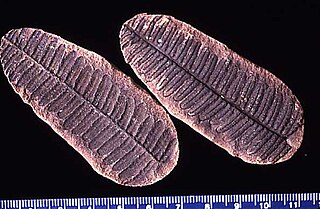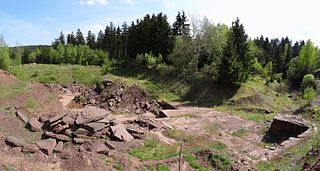In the geologic timescale, the Artinskian is an age or stage of the Permian. It is a subdivision of the Cisuralian Epoch or Series. The Artinskian likely lasted between 290.1 and 283.5 million years ago (Ma) according to the most recent revision of the International Commission on Stratigraphy (ICS) in 2022. It was preceded by the Sakmarian and followed by the Kungurian.
In the geologic timescale, the Sakmarian is an age or stage of the Permian period. It is a subdivision of the Cisuralian Epoch or Series. The Sakmarian lasted between 293.52 and 290.1 million years ago (Ma). It was preceded by the Asselian and followed by the Artinskian.

Ctenospondylus is an extinct genus of sphenacodontid synapsid

Pecopteris is a very common form genus of leaves. Most Pecopteris leaves and fronds are associated with the marattialean tree fern Psaronius. However, Pecopteris-type foliage also is borne on several filicalean ferns, and at least one seed fern. Pecopteris first appeared in the Devonian period, but flourished in the Carboniferous, especially the Pennsylvanian. Plants bearing these leaves became extinct in the Permian period, due to swamps disappearing and temperatures on Earth dropping.
Baeotherates is an extinct genus of Early Permian captorhinid reptile known from Oklahoma, United States.

The Tambach Formation is an Early Permian-age geologic formation in central Germany. It consists of red to brown-colored sedimentary rocks such as conglomerate, sandstone, and mudstone, and is the oldest portion of the Upper Rotliegend within the Thuringian Forest Basin.

Sphenopteris is a genus of seed ferns containing the foliage of various extinct plants, ranging from the Devonian to Late Cretaceous. One species, S. höninghausi, was transferred to the genus Crossotheca in 1911.
Samaropsis is a form genus named by Goeppert in 1864. Later Sewart (1917) redefined the taxon to refer only to the seeds.
Cordaicarpus is a form genus named by Geinitz (1862) and redefined by Seward (1917) to avoid confusion with another genus and to establish that the genus refers only seeds. Seward defined the differences between Cordaicarpus and Samaropsis.
Botrychiopsis is an extinct genus that existed from the Carboniferous to the Permian. Vascularized seedless plants (ferns) and reproduction by spores. They leaf type fronds. They lived in locals humid and swampy.
Cheirophyllum is an extinct plant genus that existed during the Permian.
Stephanophyllites is an extinct genus of plants that lived in the Permian.
Kawizophyllum is an extinct genus of plants that lived in the Permian.
Cyclodendron was a genus of lycophytes dating from the Permian. Plants were vascularized with reproduction by spores.
Neomariopteris is a genus of plants dating from the Permian and Triassic Lower. Vascularized seedless plants (ferns) and reproduction by spores. They leaf type fronds. They lived in locals humid and swampy.

The Archer City Formation is a geological formation in north-central Texas, preserving fossils from the Asselian and early Sakmarian stages of the Permian period. It is the earliest component of the Texas red beds, introducing an tropical ecosystem which will persist in the area through the rest of the Early Permian. The Archer City Formation is preceded by the cool Carboniferous swamp sediments of the Markley Formation, and succeeded by the equally fossiliferous red beds of the Nocona Formation. The Archer City Formation was not named as a unique geological unit until the late 1980s. Older studies generally labelled its outcrops as the Moran or Putnam formations, which are age-equivalent marine units to the southwest.
Sweetognathus is an extinct genus of conodonts in the family Sweetognathidae that evolved at the beginning of the Permian period, in near-equatorial, shallow-water seas.
Mesogondolella is an extinct genus of conodonts.
Streptognathodus is an extinct genus of conodonts from the Late Carboniferous to Early Permian.

Tshekardocoleidae is an extinct family of stem group beetles, known from the Permian. They represent some of the earliest known beetles. They first appeared during the Cisuralian, before becoming extinct at the beginning of the Guadalupian. A claimed Jurassic record is doubtful. Like other primitive beetles, they are thought to have been xylophagous. The oldest known beetle, Coleopsis, was originally assigned to this family, but is now assigned to its own family Coleopsidae.






